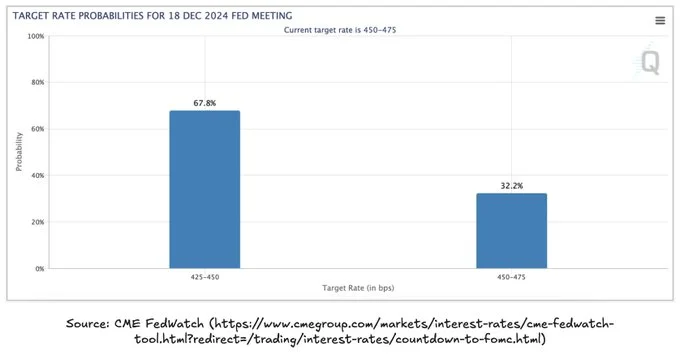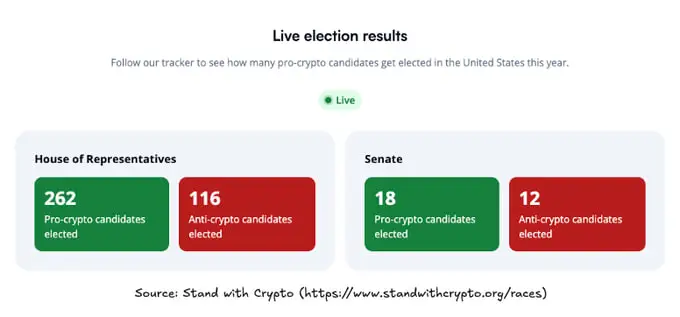With the election of the most crypto-friendly president to date in the United States and the continuation of rate cuts, the crypto community is abuzz with optimism. Could these changes herald the start of a new bull crypto market? Here’s a closer look at the 5 major economic adjustments and policy shifts that could become potential drivers for a new bullrun on the crypto market.
1. Fed Rate Cut and Quantitative Easing: Fueling Liquidity
Following this month’s Federal Open Market Committee (FOMC) meeting, market sentiment is optimistic for continued rate cuts in December, with a strong, over 65% probability of an additional 25 basis points cut. Such moves would signal a gradual shift in the Federal Reserve’s stance towards a more accommodative policy, possibly foreshadowing a full pivot in the coming months.

Meanwhile, China’s People’s Bank (PBC) has already announced its largest stimulus package since the pandemic, injecting liquidity and confidence into the economy. If the Fed follows suit, it would contribute to a global easing cycle that could significantly enhance market liquidity. Together, these cuts and stimuli would expand liquidity, potentially paving the way for a new bull cycle across various asset classes, including cryptocurrencies.
2. Changed Political Landscape: Regulatory Revolution for Crypto?
The recent U.S. election has brought the most pro-crypto candidates yet to Congress, alongside a crypto-friendly president Donald Trump: data from Coinbase’s Stand With Crypto initiative indicates that 247 pro-crypto candidates won seats in the House of Representatives.

Along with high chances for the Fed rate cut, this combination creates an unprecedented opportunity for regulatory reform on the crypto market, with several critical areas that could see positive change:
- Clearer regulation for digital assets;
- New legal status for Bitcoin and its possible use by the government;
- Advancement of crypto-based ETFs;
- Enhanced support for innovations in DeFi;
Bitcoin as a Strategic Reserve
Earlier this year, Trump endorsed the idea of including Bitcoin as a national strategic reserve asset. Shortly after, Senator Cynthia Lummis introduced legislation, known as the “Bitcoin Act,” proposing to add Bitcoin to the U.S. government’s official reserve assets.
Though the act is yet to pass, it represents a substantial step toward the legitimacy of Bitcoin as a national asset. If successful, it could increase public confidence in Bitcoin and elevate crypto assets as an integral part of financial strategy. The move could also serve as a precedent for other nations, reinforcing Bitcoin’s position as a store of value and hedging asset on a global scale.
FIT 21: New Regulatory Framework
The election of a pro-crypto Congress could significantly influence the passing of the Financial Innovation and Technology for the 21st Century Act (FIT 21). This act aims to clarify the regulatory landscape by distinguishing between digital commodities and securities, a decision that could directly impact ongoing SEC investigations, such as the case involving Uniswap.
A favourable outcome for FIT 21 would provide the legal basis for DeFi protocols to implement fee switches and other governance features without fear of regulatory backlash. This would enable projects like Ethena’s ENA, which already has a fee-switch proposal, to explore new monetisation avenues, thereby fostering growth and innovation in the space. The market seems to be responding positively, with major DeFi protocols experiencing upward price momentum.
This progress could trickle down to smaller DeFi projects, potentially triggering a resurgence of the sector as a whole in the coming months.
ETFs: Emerging Opportunity for Solana
Trump’s election has already spurred renewed demand for Bitcoin, as evidenced by ETF activity reaching a record daily trading volume of $4.1 billion amid the presidential election outcome, with $1 billion transacted in less than 20 minutes. Following the successful launch of Ethereum ETFs in July, attention is turning toward other prominent assets, with asset managers already filing for a Solana ETF.
The introduction of a Solana ETF could provide substantial tailwinds for the SOL coin and its ecosystem, particularly for Solana-based projects and tokens. The ETF would further solidify Solana’s position as a major blockchain network and could drive increased institutional interest in the asset.
This shift may also affect the long-term performance of SOL relative to ETH. With Ethereum gradually losing its regulatory edge as competitors like Solana emerge, institutional investors may view SOL as an alternative with potentially higher upside, particularly as it continues to position itself as the “original ETH killer.”
Overall
The combination of a pro-crypto U.S. president, potential rate cuts, and a favourable regulatory landscape presents a promising backdrop for a new crypto bull market. With heightened liquidity from economic easing and supportive political momentum, opportunities for regulatory reform and market expansion in digital assets are on the rise. From Bitcoin’s potential as a strategic reserve asset to advances in DeFi and new ETFs for assets like Solana, these developments could not only bolster confidence but also pave the way for significant growth in the crypto ecosystem, drawing in both institutional and retail interest.
